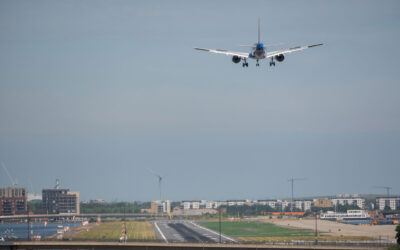Carbon Handprint vs Carbon Footprint
What’s the Difference and Why Does it Matter for Business Travel?In today’s world, we are all aware of the impact our actions have on the environment. From using plastic bags to driving a car, our daily activities contribute to our carbon footprint, which refers to the amount of carbon dioxide and other greenhouse gases emitted into the atmosphere as a result of our activities. However, what is less well known is the concept of a carbon handprint, which is the positive impact we can make on the environment through our actions. Understanding the difference between a carbon handprint and a carbon footprint is crucial for businesses, especially those in the travel industry, to take effective steps towards sustainable and responsible practices.
A carbon footprint is a measure of the total amount of greenhouse gases, including carbon dioxide, methane, and nitrous oxide, that are emitted as a result of human activities such as transportation, energy use, and production processes. It is usually expressed in metric tonnes of carbon dioxide equivalent (CO2e). When we talk about carbon footprint, we are referring to the negative impact that our actions have on the environment. For example, flying is one of the most carbon-intensive activities we can undertake, and it is estimated that a single long-haul flight can produce more carbon emissions than the average person in some developing countries generates in a year.
On the other hand, a carbon handprint is the positive impact we can make on the environment through our actions. A carbon handprint is the measurement of the amount of carbon dioxide that is prevented from being released into the atmosphere as a result of our actions. For example, a business that invests in renewable energy, such as wind or solar power, is creating a positive carbon handprint by reducing its carbon footprint and preventing the release of greenhouse gases into the atmosphere.
One company’s carbon handprint helps reduce the carbon footprint of another.
Carbon Handprint
A measure of how much products and services are helping others cut their GHG emissions.
You want it to be BIG.
Carbon Footprint
A measure of GHG emissions for an individual, event, organisation, service, place or product.
You want it to be SMALL.
The concept of a carbon handprint is relatively new, and it is not yet as widely understood as the concept of a carbon footprint. However, it is important for businesses to take both into account when considering their environmental impact. By focusing solely on reducing their carbon footprint, businesses may miss opportunities to create a positive impact on the environment through their actions.
For businesses in the travel industry, the impact of carbon emissions is particularly significant. Travel and tourism account for around 8% of global greenhouse gas emissions, and this figure is set to rise as the industry continues to grow. Business travel, in particular, is a major contributor to carbon emissions, with air travel being the most carbon-intensive mode of transport. It is estimated that business travel accounts for around 12% of all flights taken, and this figure is expected to continue to rise.
Reducing carbon emissions from business travel is therefore crucial, but it is not enough to focus solely on reducing the carbon footprint of business travel. Businesses also need to consider the potential positive impact they can have through their actions. For example, a business that invests in renewable energy to power its offices and facilities is creating a positive carbon handprint by reducing its carbon footprint and preventing the release of greenhouse gases into the atmosphere.
Another way that businesses can create a positive carbon handprint is by promoting sustainable and responsible travel practices among their employees. For example, businesses can encourage employees to use videoconferencing and other digital technologies to reduce the need for travel. They can also provide incentives for employees who choose to travel by public transport, bicycle, or on foot rather than by car or plane.

Understanding the difference between a carbon footprint and a carbon handprint is crucial for businesses, especially those in the travel industry and those who travel for work, to take effective steps towards sustainable and responsible practices. While reducing carbon emissions is important, businesses also need to consider the positive impact they can have through their actions. By investing in renewable energy, promoting sustainable travel practices, and ensuring your travel policy reflects and rewards good corporate citizenship, you can give a helping hand – your carbon hand(print) – to the wider environment.
LEGACY
Sustainable Travel Programme
Responsible travel isn’t just about calculating your carbon footprint per trip and planting a tree to make you feel better about yourself. It’s ensuring the future of our planet for business travellers to come. That’s why we’ve teamed up with Forest Carbon and our own parent company, Inchcape Family Estate in Scotland, to devise a meaningful and practical solution to sustainable travel. With woodland and peatland developments throughout the UK, you can see and touch the difference this programme makes.
Now is the time to build a lasting and tangible carbon-offset programme for your business travel impact. Now is the time to build a Legacy.
Related Articles
Toronto: A Business Traveller’s Guide
Located on the north-western shore of Lake Ontario, Toronto is a vibrant metropolis known for its multiculturalism, thriving economy, and global business influence. Originally founded in the 18th century as a British colonial town named York, the city adopted the Indigenous name “Toronto” in 1834 – thought to derive from the Mohawk word tkaronto, meaning “where trees stand in the water.”
Today, Toronto is Canada’s financial and tech capital, home to the headquarters of major banks, global consulting firms, and innovative startups. With one of the most diverse populations in the world and a booming downtown core, it’s an ideal destination for international professionals. In this comprehensive guide to Toronto for business travellers, we delve deeper into navigating the city’s unique corporate landscape, offer our top tips for getting around, and pick out our top 3 things to see or do to make your trip unforgettable.
Inside the Business Travel Show Europe 2025
Held in the huge conference halls of ExCeL London, the Business Travel Show Europe 2025 was a sparkling celebration of the innovation within the industry, and we at Gray Dawes were proud to be at the beating heart of it all. In this article, we take you behind the scenes of the show, reflect on a few eye-opening days, and share how Gray Dawes continues to lead the way with our Always On approach to delivering High Touch, High Tech, and High Content service at every stage of a business trip.
Onwards and Upwards with ITA Airways
ITA Airways, Italy’s flagship carrier, has expanded significantly since we last spoke with them. They now operate as far east as Tokyo and as far west as San Francisco. In this article, we chat to ITA Airways about their integration with Lufthansa Group, their commitment to sustainable travel, their Volare points program, and much more.




